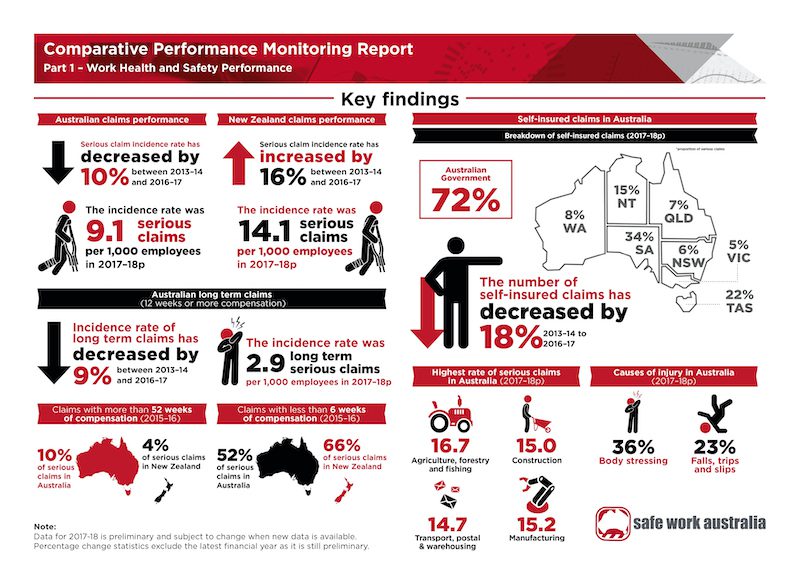Workplace Health and Safety authorities across Australia undertook 230,054 workplace interventions, issued 46,472 notices for workplace health and safety breaches and finalised 289 legal proceedings between 2013-14 and 2016-17, resulting in $18.9 million in fines ordered by the courts, according to a recent Safe Work Australia report.
It also found that the total expenditure for workers’ compensation schemes across Australia was $8.457 billion in 2017-18.
The overall Australian incidence rate for serious workers compensation claims has steadily declined over the past four years, falling by 10 per cent from 10.3 to 9.3 claims per 1,000 employees between 2013–14 and 2016–17, according to The Comparative Performance Monitoring report 21st edition.
Furthermore, preliminary data for 2017–18 shows an incidence rate of 9.1 claims per 1,000 employees, however, this is expected to be revised upwards when updated data is available.
The report found that between 2013–14 and 2016–17 all Australian jurisdictions except the Australian Capital Territory recorded falls in the incidence rate of serious claims.
READ RELATED
- Safety from the top down – Q&A with Dr Kirstin Ferguson
- Safety report card for mining released
- Safe Work Australia releases Australian Workers’ Compensation Statistics 2011-12 report.
The Australian Government recorded the largest decrease (down by 38 per cent), followed by South Australia (down 29 per cent), Seacare and the Northern Territory (down 19 per cent each), and Victoria (down 12 per cent).
Preliminary data shows that Seacare recorded the highest incidence rate of serious claims in 2017–18 with 17.3 claims per 1,000 employees, while the Australian Government recorded the lowest rate with 3.9 claims per 1,000 employees.
The overall Australian frequency rate of serious claims decreased by 8 per cent from 6.2 claims per million hours worked in 2013–14 to 5.7 in 2016–17.
Preliminary data show that the Australian frequency rate of serious claims has decreased slightly to 5.5 claims per million hours worked in 2017–18.
Although the frequency rate data show a similar level of improvement to incidence rates across jurisdictions, there are differences in the ranking of jurisdictions.
Tasmania recorded the highest frequency rate at 7.6 claims per one million hours worked in 2017–18. Seacare only had the fourth highest frequency rate due to the 24-hour basis on which its frequency rates are calculated.
The incidence rate of long term (12 weeks or more compensation) injury and disease claims in Australia also decreased by 9 per cent between 2013–14 and 2016–17.
While the preliminary 2017–18 results show a further decrease in the incidence rate compared to the previous year, this data should be treated with caution as a proportion of claims from the preliminary year are likely to be still open and claimants may accrue more time lost or compensation payments in subsequent years.
On average, 32 per cent of serious claims resulted in 12 or more weeks of compensation over the five-year period.
All Australian jurisdictions, except for the Australian Capital Territory (up 3 per cent) and Queensland (unchanged), recorded a decrease in incidence rates of long-term claims over the period from 2013–14 to 2016–17.
The Australian Government recorded the highest decrease in the long-term incidence rate (down by 41 per cent) over the period, followed by South Australia (down 39 per cent), Seacare (down 14 per cent), and the Northern Territory (down 11 per cent).

When it came to work-related traumatic injury fatality data, the report found that only around 60 per cent of work-related fatalities are typically compensated.
This is in part due to self-employed workers not being covered by workers’ compensation schemes.
Many self-employed workers work in high-risk sectors such as agriculture, transport and construction.
Over the five years, on average, New South Wales has recorded the highest number of fatalities per year (39 fatalities), followed by Queensland (32 fatalities) and Victoria (28 fatalities).
However, incidence rates over the five year period show that the Northern Territory (2.4 fatalities per 100,000 workers) recorded the highest rate and the Australian Capital Territory (0.7 fatalities per 100,000 workers) recorded the lowest rate (Indicator 7b).
“It should be noted that traumatic injury fatality data can be volatile year-on-year,” the report said.
“In particular, multiple death events can impact the data, despite the efforts of jurisdictions in reducing or eliminating work-related traumatic injury fatalities.”
This content first appeared on AIHS News. We note that the Safework Australia report excluded mining regulatory activities.
Image SafeWork Australia
Read more Mining Safety News














Add Comment